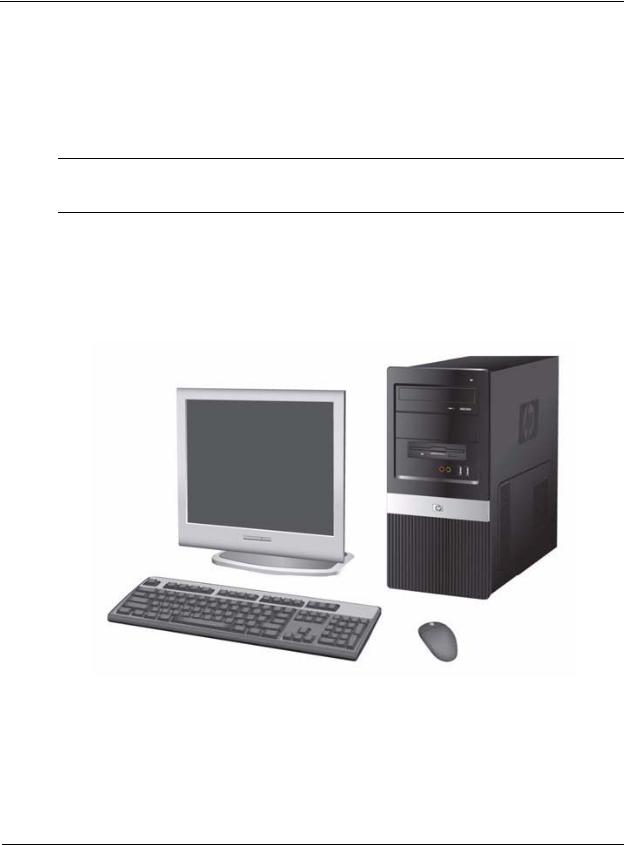HP DX2710 MT, DX2710 SFF, DX2718 MT User Manual

service reference guide
HP Compaq dx2710 MT/dx2718 MT/dx2710 SFF
Business PCs 1st Edition
This document provides information on the removal and replacement of all parts as well as information on troubleshooting, Desktop Management, setup utilities, SATA drives, safety, routine care, connector pin assignments, POST error messages, and diagnostic indicator lights.
Document Part Number 483941-001

Service Reference Guide
HP Compaq dx2710 MT/dx2718 MT/dx2710 SFF
Business PCs
1st Edition
Document Part Number: 483941-001
February 2008

© Copyright 2008 Hewlett-Packard Development Company, L.P. The information contained herein is subject to change without notice.
Microsoft, MS-DOS, Windows, and Windows NT are trademarks of Microsoft Corporation in the U.S. and other countries.
Intel is a trademark of Intel Corporation in the U.S. and other countries.
The only warranties for HP products and services are set forth in the express warranty statements accompanying such products and services. Nothing herein should be construed as constituting an additional warranty. HP shall not be liable for technical or editorial errors or omissions contained herein.
This document contains proprietary information that is protected by copyright. No part of this document may be photocopied, reproduced, or translated to another language without the prior written consent of Hewlett-Packard Company.
ÅWARNING: Text set off in this manner indicates that failure to follow directions could result in bodily harm or loss of life.
ÄCAUTION: Text set off in this manner indicates that failure to follow directions could result in damage to equipment or loss of information.
Service Reference Guide
HP Compaq dx2710 MT/dx2718 MT/dx2710 SFF Business PCs First Edition (February 2008)
Document Part Number: 483941-001

Contents
1 Installing the Operating System
1.1 Microsoft Windows XP/Windows Vista/Redflag Linux . . . . . . . . . . . . . . . . . . . . . . . . . . . . . 1–1 1.1.1 Installing or Upgrading Device Drivers (Only applicable for Windows OS) . . . . . . . . 1–1 1.2 Converting to NTFS (Associated with Windows OS) . . . . . . . . . . . . . . . . . . . . . . . . . . . . . . . 1–2
1.2.1 Windows XP Home/XP Professional(Vista downgrade)/
Vista Basic/Vista Business 32 . . . . . . . . . . . . . . . . . . . . . . . . . . . . . . . . . . . . . . . . . . . . . . . . . 1–2 1.3 HP Software . . . . . . . . . . . . . . . . . . . . . . . . . . . . . . . . . . . . . . . . . . . . . . . . . . . . . . . . . . . . . . . 1–2
2 Setup Utilities and Diagnostics Features
2.1 Power-On Self-Test (POST) . . . . . . . . . . . . . . . . . . . . . . . . . . . . . . . . . . . . . . . . . . . . . . . . . . . 2–1
2.2 Computer Setup Utilities. . . . . . . . . . . . . . . . . . . . . . . . . . . . . . . . . . . . . . . . . . . . . . . . . . . . . . 2–2
2.2.1 Using Computer Setup (F10) Utilities . . . . . . . . . . . . . . . . . . . . . . . . . . . . . . . . . . . . . . 2–2
2.2.2 Computer Setup Menu . . . . . . . . . . . . . . . . . . . . . . . . . . . . . . . . . . . . . . . . . . . . . . . . . . 2–4
2.3 Recovering the Configuration Settings. . . . . . . . . . . . . . . . . . . . . . . . . . . . . . . . . . . . . . . . . . 2–11
2.3.1 Backing up the CMOS . . . . . . . . . . . . . . . . . . . . . . . . . . . . . . . . . . . . . . . . . . . . . . . . . 2–11
2.3.2 Restoring the CMOS . . . . . . . . . . . . . . . . . . . . . . . . . . . . . . . . . . . . . . . . . . . . . . . . . . 2–11
3 Desktop Management
3.1 Initial Configuration and Deployment . . . . . . . . . . . . . . . . . . . . . . . . . . . . . . . . . . . . . . . . . . . 3–1
3.2 ROM Flash . . . . . . . . . . . . . . . . . . . . . . . . . . . . . . . . . . . . . . . . . . . . . . . . . . . . . . . . . . . . . . . . 3–1
3.2.1 FailSafe Boot Block ROM . . . . . . . . . . . . . . . . . . . . . . . . . . . . . . . . . . . . . . . . . . . . . . . 3–1
3.2.2 Dual-State Power Button . . . . . . . . . . . . . . . . . . . . . . . . . . . . . . . . . . . . . . . . . . . . . . . . 3–2
3.2.3 Power Management . . . . . . . . . . . . . . . . . . . . . . . . . . . . . . . . . . . . . . . . . . . . . . . . . . . . 3–2
3.2.4 World Wide Web Site . . . . . . . . . . . . . . . . . . . . . . . . . . . . . . . . . . . . . . . . . . . . . . . . . . 3–3
3.3 Security . . . . . . . . . . . . . . . . . . . . . . . . . . . . . . . . . . . . . . . . . . . . . . . . . . . . . . . . . . . . . . . . . . . 3–3
3.3.1 Password Security . . . . . . . . . . . . . . . . . . . . . . . . . . . . . . . . . . . . . . . . . . . . . . . . . . . . . 3–3
3.3.2 Establishing a Supervisor Password Using Computer Setup . . . . . . . . . . . . . . . . . . . . . 3–3
3.3.3 Establishing a User Password Using Computer Setup . . . . . . . . . . . . . . . . . . . . . . . . . . 3–3
3.3.4 Surge-Tolerant Power Supply . . . . . . . . . . . . . . . . . . . . . . . . . . . . . . . . . . . . . . . . . . . . 3–6
4 Serial ATA Drive Guidelines and Features
4.1 SATA 3.0 Hard Drives . . . . . . . . . . . . . . . . . . . . . . . . . . . . . . . . . . . . . . . . . . . . . . . . . . . . . . . 4–1
4.2 SATA Hard Drive Cables . . . . . . . . . . . . . . . . . . . . . . . . . . . . . . . . . . . . . . . . . . . . . . . . . . . . . 4–2
4.2.1 SATA Data Cable. . . . . . . . . . . . . . . . . . . . . . . . . . . . . . . . . . . . . . . . . . . . . . . . . . . . . . 4–2
4.2.2 SATA Power Cable . . . . . . . . . . . . . . . . . . . . . . . . . . . . . . . . . . . . . . . . . . . . . . . . . . . . 4–2
4.3 SATA SMART Drives . . . . . . . . . . . . . . . . . . . . . . . . . . . . . . . . . . . . . . . . . . . . . . . . . . . . . . . 4–3
4.4 Drive Capacities . . . . . . . . . . . . . . . . . . . . . . . . . . . . . . . . . . . . . . . . . . . . . . . . . . . . . . . . . . . . 4–3
4.5 SATA BIOS . . . . . . . . . . . . . . . . . . . . . . . . . . . . . . . . . . . . . . . . . . . . . . . . . . . . . . . . . . . . . . . 4–3
Service Reference Guide |
483941-001 |
iii |

Contents
5 Identifying the Chassis, Routine Care, and Disassembly Preparation
5.1 Chassis Designations . . . . . . . . . . . . . . . . . . . . . . . . . . . . . . . . . . . . . . . . . . . . . . . . . . . . . . . . 5–1 5.1.1 Microtower (MT)/Small Form Factor (SFF) . . . . . . . . . . . . . . . . . . . . . . . . . . . . . . . . . 5–1 5.2 Electrostatic Discharge Information . . . . . . . . . . . . . . . . . . . . . . . . . . . . . . . . . . . . . . . . . . . . . 5–3 5.2.1 Generating Static . . . . . . . . . . . . . . . . . . . . . . . . . . . . . . . . . . . . . . . . . . . . . . . . . . . . . . 5–3 5.2.2 Preventing Electrostatic Damage to Equipment. . . . . . . . . . . . . . . . . . . . . . . . . . . . . . . 5–3 5.2.3 Personal Grounding Methods and Equipment . . . . . . . . . . . . . . . . . . . . . . . . . . . . . . . . 5–4 5.2.4 Grounding the Work Area . . . . . . . . . . . . . . . . . . . . . . . . . . . . . . . . . . . . . . . . . . . . . . . 5–4 5.2.5 Recommended Materials and Equipment. . . . . . . . . . . . . . . . . . . . . . . . . . . . . . . . . . . . 5–4
5.3 Routine Care . . . . . . . . . . . . . . . . . . . . . . . . . . . . . . . . . . . . . . . . . . . . . . . . . . . . . . . . . . . . . . . 5–5 5.3.1 General Cleaning Safety Precautions . . . . . . . . . . . . . . . . . . . . . . . . . . . . . . . . . . . . . . . 5–5 5.3.2 Cleaning the Computer Case . . . . . . . . . . . . . . . . . . . . . . . . . . . . . . . . . . . . . . . . . . . . . 5–5 5.3.3 Cleaning the Keyboard . . . . . . . . . . . . . . . . . . . . . . . . . . . . . . . . . . . . . . . . . . . . . . . . . . 5–6 5.3.4 Cleaning the Monitor . . . . . . . . . . . . . . . . . . . . . . . . . . . . . . . . . . . . . . . . . . . . . . . . . . . 5–6 5.3.5 Cleaning the Mouse . . . . . . . . . . . . . . . . . . . . . . . . . . . . . . . . . . . . . . . . . . . . . . . . . . . . 5–6
5.4 Service Considerations . . . . . . . . . . . . . . . . . . . . . . . . . . . . . . . . . . . . . . . . . . . . . . . . . . . . . . . 5–7 5.4.1 Tools and Software Requirements . . . . . . . . . . . . . . . . . . . . . . . . . . . . . . . . . . . . . . . . . 5–7 5.4.2 Screws. . . . . . . . . . . . . . . . . . . . . . . . . . . . . . . . . . . . . . . . . . . . . . . . . . . . . . . . . . . . . . . 5–7 5.4.3 Cables and Connectors . . . . . . . . . . . . . . . . . . . . . . . . . . . . . . . . . . . . . . . . . . . . . . . . . . 5–8 5.4.4 Hard Drives . . . . . . . . . . . . . . . . . . . . . . . . . . . . . . . . . . . . . . . . . . . . . . . . . . . . . . . . . . 5–8 5.4.5 Lithium Coin Cell Battery . . . . . . . . . . . . . . . . . . . . . . . . . . . . . . . . . . . . . . . . . . . . . . . 5–8
6Removal and Replacement Procedures — Microtower (MT)/ Small Form Factor (SFF) Chassis
6.1 |
Preparation for Disassembly . . . . . . . . . . . . . . . . . . . . . . . . . . . . . . . . . . . . . . . . . . . . . . . . . |
. 6–1 |
|
6.2 |
Remove the computer access panel and front bezel (MT chassis and SFF chassis). . . . . . . . |
6–2 |
|
|
6.2.1 Access Panel (MT Chassis) . . . . . . . . . . . . . . . . . . . . . . . . . . . . . . . . . . . . . . . . . . . . . . |
6–2 |
|
|
6.2.2 Front Bezel (MT Chassis) . . . . . . . . . . . . . . . . . . . . . . . . . . . . . . . . . . . . . . . . . . . . . . . |
6–3 |
|
|
6.2.3 |
Removing the Computer Access Panel and Front Bezel (SFF chassis) . . . . . . . . . . . . |
6–4 |
6.3 |
Using the Small Form Factor Computer in a Minitower Configuration. . . . . . . . . . . . . . . . . . |
6–6 |
|
6.4 |
Front Drive Bezels . . . . . . . . . . . . . . . . . . . . . . . . . . . . . . . . . . . . . . . . . . . . . . . . . . . . . . . . . . |
6–7 |
|
|
6.4.1 Removing a 5.25" Drive Bezel Blank/MT Chassis . . . . . . . . . . . . . . . . . . . . . . . . . . . . |
6–7 |
|
6.5 |
Memory . . . . . . . . . . . . . . . . . . . . . . . . . . . . . . . . . . . . . . . . . . . . . . . . . . . . . . . . . . . . . . . . . . |
6–8 |
|
|
6.5.1 Installing Memory Modules/MT chassis . . . . . . . . . . . . . . . . . . . . . . . . . . . . . . . . . . . . |
6–8 |
|
|
6.5.2 |
Installing DDR2-SDRAM DIMMs - SFF chassis. . . . . . . . . . . . . . . . . . . . . . . . . . . . . |
6–9 |
6.6 |
Expansion Cards . . . . . . . . . . . . . . . . . . . . . . . . . . . . . . . . . . . . . . . . . . . . . . . . . . . . . . . . . . . |
6–11 |
|
|
6.6.1 Expansion Slot Cover Lock . . . . . . . . . . . . . . . . . . . . . . . . . . . . . . . . . . . . . . . . . . . . . |
6–11 |
|
|
6.6.2 |
PCI/PCIe Expansion Card . . . . . . . . . . . . . . . . . . . . . . . . . . . . . . . . . . . . . . . . . . . . . . |
6–11 |
|
6.6.3 Installing an Expansion Card . . . . . . . . . . . . . . . . . . . . . . . . . . . . . . . . . . . . . . . . . . . . |
6–13 |
|
|
6.6.4 Removing an Expansion Card . . . . . . . . . . . . . . . . . . . . . . . . . . . . . . . . . . . . . . . . . . . |
6–15 |
|
6.7 |
Cable Management . . . . . . . . . . . . . . . . . . . . . . . . . . . . . . . . . . . . . . . . . . . . . . . . . . . . . . . . |
6–16 |
|
6.8 |
Drives . . . . . . . . . . . . . . . . . . . . . . . . . . . . . . . . . . . . . . . . . . . . . . . . . . . . . . . . . . . . . . . . . . . |
6–17 |
|
|
6.8.1 |
Locating Drive Positions . . . . . . . . . . . . . . . . . . . . . . . . . . . . . . . . . . . . . . . . . . . . . . . |
6–17 |
|
6.8.2 |
Removing a Drive . . . . . . . . . . . . . . . . . . . . . . . . . . . . . . . . . . . . . . . . . . . . . . . . . . . . |
6–18 |
|
6.8.3 Locating Drive Positions - SFF chassis . . . . . . . . . . . . . . . . . . . . . . . . . . . . . . . . . . . . |
6–21 |
|
|
6.8.4 Removing an Optical Drive or Diskette Drive - SFF chassis. . . . . . . . . . . . . . . . . . . . |
6–22 |
|
|
6.8.5 Installing an Optional Optical Drive - SFF chassis . . . . . . . . . . . . . . . . . . . . . . . . . . . |
6–23 |
|
|
6.8.6 Upgrading the Hard Drive - SFF chassis . . . . . . . . . . . . . . . . . . . . . . . . . . . . . . . . . . . |
6–26 |
|
iv |
483941-001 |
Service Reference Guide |

|
|
Contents |
6.9 |
Front I/O Panel Housing Assembly - MT chassis . . . . . . . . . . . . . . . . . . . . . . . . . . . . . . |
. . 6–28 |
6.10 |
System Fan . . . . . . . . . . . . . . . . . . . . . . . . . . . . . . . . . . . . . . . . . . . . . . . . . . . . . . . . . . . . . |
. . 6–29 |
6.11 |
Heatsink - MT chassis. . . . . . . . . . . . . . . . . . . . . . . . . . . . . . . . . . . . . . . . . . . . . . . . . . . . . . |
. 6–30 |
6.12 |
Processor . . . . . . . . . . . . . . . . . . . . . . . . . . . . . . . . . . . . . . . . . . . . . . . . . . . . . . . . . . . . . . . |
. 6–31 |
6.13 |
System Board . . . . . . . . . . . . . . . . . . . . . . . . . . . . . . . . . . . . . . . . . . . . . . . . . . . . . . . . . . . . |
. 6–33 |
6.14 |
Battery. . . . . . . . . . . . . . . . . . . . . . . . . . . . . . . . . . . . . . . . . . . . . . . . . . . . . . . . . . . . . . . . . . |
. 6–34 |
|
6.14.1Battery Holder . . . . . . . . . . . . . . . . . . . . . . . . . . . . . . . . . . . . . . . . . . . . . . . . . . . . . . |
. 6–35 |
6.15 |
Power Supply . . . . . . . . . . . . . . . . . . . . . . . . . . . . . . . . . . . . . . . . . . . . . . . . . . . . . . . . . . . . |
. 6–36 |
AConnector Pin Assignments
BPower Cord Set Requirements
CPOST Error Messages
DTroubleshooting Without Diagnostics
EMemory
Service Reference Guide |
483941-001 |
v |

1
Installing the Operating System
Depending on the model, Microsoft Windows XP Home, Windows XP Professional (Vista Downgrade), Windows Vista Basic, Windows Vista Business 32 or Redflag Linux is preinstalled on the computer and will be configured automatically the first time the computer is turned on.
ÄCAUTION: Do not add optional hardware devices to your computer until the operating system is successfully installed. Doing so may cause errors and may prevent the operating system from installing properly.
ÄCAUTION: Once the automatic installation has begun, DO NOT TURN OFF THE COMPUTER UNTIL THE PROCESS IS COMPLETE. Turning off the computer during the installation process might damage the software that runs the computer.
1.1Microsoft Windows XP/Windows Vista/ Redflag Linux
The first time the computer is turned on, Microsoft Windows or Redflag Linux is automatically installed. This takes several minutes, depending on the system hardware configuration. Read and follow the instructions that appear on the screen to complete the installation. During this process, do not turn off your computer unless you are directed to do so.
1.1.1Installing or Upgrading Device Drivers (Only applicable for Windows OS)
To install optional hardware devices after the OS installation is completed, you must install the device drivers for the device you are installing.
The I386 directory and its subdirectories provide the HPor Compaq-specific integration of the operating system for the computer model and include device drivers supported by the operating system.
When prompted for the I386 directory on the operating system CD, replace the path with C:\I386 or use the Browse button of the dialog box to browse the computer for the I386 folder. This action
points to the appropriate drivers.
The latest support software is also available from the Web site at http://www.hp.com/support.
At product launch, Vista capable program is applied for some of satisfied system shipment. (Major consideration of whether applicable is to meet minimum 1GB memory or not.)
Service Reference Guide |
483941-001 |
1–1 |

Installing the Operating System
1.2Converting to NTFS (Associated with Windows OS)
1.2.1Windows XP Home/XP Professional(Vista downgrade)/ Vista Basic/Vista Business 32
The Windows XP Home/XP Professional (Vista downgrade)/Vista Basic/Vista Business 32 operating systems handle only NTFS-formatted drives. When installed, XP or Vista will, if necessary, automatically convert a FAT32 drive to NTFS.
1.3HP Software
The Microsoft Windows operating system (Windows XP Home or XP Professional(Vista downgrade) or Vista Basic or Vista Business 32) is preinstalled on the computer and will be configured automatically the first time the computer is turned on. All other software is userinstalled.
Certain drivers and utilities are available only in selected languages. You can obtain the latest version of these files, in English and selected other languages, in one of these ways:
■HP web site at www.hp.com
■Restore Plus! CD, which is supplied with many Compaq models
Additional HP software may be required in certain situations.
1–2 |
483941-001 |
Service Reference Guide |

2
Setup Utilities and Diagnostics Features
Setup Utilities (F10) and diagnostic features provide information needed about the computer system when contacting Customer Support. These tools can also be used to:
■Change factory default settings and to set or change the system configuration, which may be necessary when you add or remove hardware.
■Determine if all of the devices installed on the computer are recognized by the system and functioning properly.
■Determine information about the operating environment of the computer.
■Solve system configuration errors detected but not automatically fixed during the Power-On Self-Test (POST).
■Establish and manage passwords and other security features.
■Establish and manage energy-saving timeouts.
All features identified in this chapter may not be available on all HP products.
2.1Power-On Self-Test (POST)
POST is a series of diagnostic tests that runs automatically when the system is turned on. POST checks the following items to ensure that the computer system is functioning properly:
■Keyboard
■Memory modules
■Diskette drives
■All IDE (ATA) and SATA mass storage devices
■Processors
■Controllers
If the Supervisor Password is set, a key icon appears on the screen while POST is running. You will need to enter the password before continuing. Refer to Chapter 3, Section 3.1, “Initial Configuration and Deployment,” for information on setting, deleting, or bypassing the password.
If POST finds an error in the system, an audible and/or visual message occurs. For POST error messages and their solutions refer to Appendix C, “POST Error Messages.”
Service Reference Guide |
483941-001 |
2–1 |

Setup Utilities and Diagnostics Features
2.2 Computer Setup Utilities
Use Computer Setup Utilities (F10) to:
■Modify or restore factory default settings.
■Set the system date and time.
■Set, view, change, or verify the system configuration including settings for processor, graphics, memory, audio, storage, communications, and input devices.
■Modify the boot order of bootable devices such as hard drives, diskette drives, optical drives, USB devices.
■Configure the boot priority of IDE (ATA) and SATA hard drive controllers.
■Enable or disable Network Server Mode, which allows the computer to boot the operating system when the power-on password is enabled with or without a keyboard or mouse attached. When attached to the system, the keyboard and mouse remain locked until the power-on password is entered.
■Enable supervisor password prompting during system restarts (warm boots) as well as during power-on.
■Establish a supervisor password that controls access to Computer Setup (F10) Utility and the settings described in this section.
■Enable or disable removable media boot ability.
■Enable or disable removable media write ability (when supported by hardware).
■Solve system configuration errors detected but not automatically fixed during the Power-On Self-Test (POST).
■Execute self-tests on a specified IDE (ATA) hard drive (when supported by the drive).
2.2.1Using Computer Setup (F10) Utilities
Computer Setup can be accessed only by turning on the computer or restarting the system. To access the Computer Setup Utilities menu, complete the following steps:
1.Turn on or restart the computer. If you are in Windows, click Start > Shut Down > Restart.
2.As soon as the computer is turned on, press and hold the F10 key until you enter Computer Setup. Press Enter to bypass the title screen, if necessary.
If you do not press the F10 key at the appropriate time, you must turn the computer off, then on again, and press the F10 key again to access the utility.
If you are using a PS/2 keyboard, you may see a Keyboard Error message—disregard it.
2–2 |
483941-001 |
Service Reference Guide |

Setup Utilities and Diagnostics Features
3.A choice of headings appears in the Computer Setup Utilities menu: System Information, Standard CMOS Features, Advanced BIOS Features, Advanced Chipset Features, Integrated Peripherals, Power Management Setup, PnP/PCI Configurations, Hardware Monitor Setup, Load Defaults Setting, Set Supervisor Password, Set User Password, Save Setting and Exit, and Exit Without Saving.
4.Use the arrow (left and right) keys to select the appropriate heading. Use the arrow (up and down) keys to select the option you want, then press Enter. To return to the Computer Setup Utilities menu, press Esc.
5.To apply and save changes, select Save Setting and Exit.
If you have made changes that you do not want applied, select Exit Without Saving.
To reset to factory settings, select Load Defaults Setting. This option will restore the original factory system defaults. You must still select Save Setting and Exit after resetting the defaults.
ÄCAUTION: Do NOT turn the computer power OFF while the ROM is saving your F10 Computer Setup changes because the CMOS could become corrupted. It is safe to turn off all power to the computer after you exit the F10 Setup screen.
Service Reference Guide |
483941-001 |
2–3 |

Setup Utilities and Diagnostics Features
2.2.2 Computer Setup Menu
Computer Setup
Heading |
Option |
Description |
|
|
|
|
|
System |
System S/N |
(view only) |
|
Information |
|
|
|
Product Name |
(view only) |
||
|
|||
|
|
|
|
|
OwnerShip TAG |
Enter ownership tag assigned by the owner. |
|
|
[Press Enter] |
|
|
|
|
|
|
|
OwnerShip TAG |
(view only) |
|
|
|
|
|
|
BIOS Version |
(view only) |
|
|
|
|
|
|
BIOS Release Date |
(view only) |
|
|
|
|
|
|
System Chipset Type |
(view only) |
|
|
|
|
|
|
Processor Type |
(view only) |
|
|
|
|
|
|
Processor Speed |
(view only) |
|
|
|
|
|
|
CPU ID |
(view only) |
|
|
|
|
|
|
Cache Size |
(view only) |
|
|
|
|
|
|
Memory DIMM1 |
(view only) |
|
|
|
|
|
|
Memory DIMM2 |
(view only) |
|
|
|
|
|
|
Memory DIMM3 |
(view only) |
|
|
|
|
|
|
Memory DIMM4 |
(view only) |
|
|
|
|
|
|
DDR2 Memory Size |
(view only) |
|
|
|
|
|
|
UUID |
(view only) |
|
|
|
|
|
|
Chassis Serial Number |
When user enter to setup with advanced |
|
|
[Press Enter] |
mode (Ctrl+A) |
|
|
|
|
|
|
Chassis Serial Number |
(view only) |
|
|
|
|
|
|
Asset TAG Number |
Enter asset tag assigned by the company. |
|
|
[Press Enter] |
|
|
|
|
|
|
|
Asset TAG Number |
(view only) |
|
|
|
|
|
|
Integrated MAC |
(view only) |
|
|
|
|
|
Standard |
System Date |
Allows you to set system date. |
|
CMOS |
|
|
|
System Time |
Allows you to set system time. |
||
Features |
|||
|
|
||
|
Floppy Drive A |
Allows you to set Drive A to None or 1.44M, |
|
|
|
3.5 inch. |
Support for specific Computer Setup options may vary depending on the hardware configuration.
2–4 |
483941-001 |
Service Reference Guide |

Setup Utilities and Diagnostics Features
Computer Setup (Continued)
Heading
Standard
CMOS
Features
(continued)
Option |
Description |
|
|
|
|
SATA Port 0 |
For each, allows you to: |
|
SATA Port 1 |
• IDE Channel 0 |
Master (for SATA Port 0 Only) |
SATA Port 2 |
• IDE Channel 1 |
Slave (for SATA Port 1 Only) |
SATA Port 3 |
• detect HDD size and head on selected |
|
|
channel |
|
•set extended drive on selected channel to (for SATA Port 2 and port 3 only):
•None
•Auto
•set access mode on selected channel to:
•CHS
•LBA
•Large
•Auto
•view:
•Capacity
•Cylinder
•Head
•Precomp
•Landing Zone
•Sector
Legacy Mode Support |
Disable |
(for SATA 0/1 ONLY) |
Enable |
|
|
Halt On |
Allows you to set at: |
|
• All Errors |
|
• No Errors |
|
• All but Keyboard |
|
• All but Diskette |
|
• All but Disk/Key |
Advanced |
F11 Prompt |
Allow you to enable or disable this feature. |
|
BIOS Features |
|
|
|
Quick Power On Self Test |
Disables/enables the system to skip certain |
||
|
|||
|
|
tests while booting. |
|
|
|
Enabling this feature decreases the time |
|
|
|
required to boot the system. |
|
|
|
|
|
|
POST Delay Time (seconds) |
Allows you to set a POST delay time to: |
|
|
|
• 0 Sec |
|
|
|
• 5 Sec |
|
|
|
• 10 Sec |
|
|
|
• 15 Sec |
|
|
|
• 20 Sec |
Support for specific Computer Setup options may vary depending on the hardware configuration.
Service Reference Guide |
483941-001 |
2–5 |

Setup Utilities and Diagnostics Features
Computer Setup (Continued)
Heading |
Option |
Description |
|
|
|
Advanced |
Removeable Device Priority |
Allow you to select FDD or USB-FDD as the |
BIOS Features |
|
first removeable device. |
(continued) |
|
|
Hard Disk Boot Priority |
Allows you to specify the order of attached |
|
|
|
hard drive devices (such as USB HDD |
|
|
storage, USB2 Drive Key, or USB flash |
|
|
media, IDE HDD, SATA HDD or bootable |
|
|
add-in cards). The first drive in the order has |
|
|
priority in the boot sequence and is |
|
|
recognized as drive C (if any devices are |
|
|
attached). |
|
|
|
|
CD-ROM Boot Priority |
Allows you to specify the order of attached |
|
|
optical drive device. |
|
|
|
|
Network Boot Priority |
Allows you to specify the order of network |
|
|
device. |
First Boot Device
Second Boot Device
Third Boot Device
Fourth Boot Device
Allows you to specify which devices will boot first, second, and third, or to disable any of the three:
•Removable
•Hard Disk
•CD-ROM
•Network
•Disabled
|
MS-DOS drive lettering assignments |
|
may not apply after a non-MS-DOS |
|
operating system has started. |
|
|
Boot Other Device |
Disables/enables boot other device. |
|
|
Load Boot Menu Selectable |
Disables/enables boot menu selectable |
|
|
APIC Mode |
Disables/enables the APIC mode. |
|
Modifiable when Hyper-Threading |
|
Technology is DISABLED. |
|
|
Hyper-Threading Technology |
Disable/ enables Hyper-Threading |
|
technology. This item will show when the |
|
CPU supports Hyper-Threading technology. |
|
|
System Keyboard |
Allows you to set system keyboard to absent |
|
or present. |
|
|
Boot Up NumLock Status |
Allows you to set the default NumLock status |
|
to off or on. |
|
|
Security Option |
Allows you to set the security option to Setup |
|
or System so that the password is required |
|
every time the system boots or only when |
|
entering Computer Setup. |
Support for specific Computer Setup options may vary depending on the hardware configuration.
2–6 |
483941-001 |
Service Reference Guide |

|
|
|
Setup Utilities and Diagnostics Features |
|
|
|
|
|
|
|
Computer Setup (Continued) |
|
|
|
|
|
|
|
|
|
Heading |
Option |
Description |
|
|
|
|
|
|
|
Advanced |
PEG/Onchip VGA Control |
Allows you to set system display at: |
|
|
Chipset |
(VGA Setting) |
• Onchip VGA |
|
|
Features |
|
• PEG Port |
|
|
|
|
||
|
|
|
• Auto |
|
|
|
|
|
|
|
|
On-Chip Frame Buffer Size |
Allow you to set On-Chip Frame Buffer Size |
|
|
|
(VGA Setting |
to. Modifiable when PEG/Onchip VGA |
|
|
|
|
Control is Onchip VGA or Auto: |
|
|
|
|
• 1MB |
|
|
|
|
• 8MB |
|
|
|
DVMT Mode |
Allows you to set DVMT Mode to: |
|
|
|
(VGA Setting) |
• Fixed |
|
|
|
|
• DVMT |
|
DVMT/FIXED Memory Size
(VGA Setting)
Allows you to set memory size to. Modifiable when PEG/Onchip VGA Control is Onchip VGA or Auto:
•128MB
•256MB
•MAX.
Disable MCHBAR MMIO |
Disable/ enable this feature |
|
|
Init Display First |
Allows you to set system display priority: |
(VGA Setting) |
• PCI Slot |
|
• Onboard |
Support for specific Computer Setup options may vary depending on the hardware configuration.
Service Reference Guide |
483941-001 |
2–7 |

Setup Utilities and Diagnostics Features
Computer Setup (Continued)
Heading |
Option |
Description |
|
|
|
|
|
Integrated |
USB Controller |
Disables/enables USB controller. |
|
Peripherals |
|
|
|
USB Legacy Support |
Disables/enables USB legacy support. |
||
|
|||
|
|
|
|
|
HD Audio |
Allows you to auto-detect or disable onboard |
|
|
|
audio. |
|
|
|
|
|
|
Onboard LAN |
Disables/enables onboard LAN controller. |
|
|
|
|
|
|
Onboard LAN Boot ROM |
Disables/enables the boot ROM of the |
|
|
|
onboard LAN chip. |
|
|
|
|
|
|
Onboard FDC Controller |
Disables/enables onboard FDC controller. |
|
|
|
|
|
|
Serial Port 1/2 |
Allows you to select a setting for the onboard |
|
|
|
serial port: |
|
|
|
• Disabled |
|
|
|
• 3F8/IRQ4 |
|
|
|
• 2F8/IRQ3 |
|
|
|
• 3E8/IRQ4 |
|
|
|
• 2E8/IRQ3 |
|
|
|
• Auto |
|
|
|
|
|
|
Parallel port |
Allows you to select a setting for the onboard |
|
|
|
parallel port: |
|
|
|
• Disabled |
|
|
|
• 378/IRQ7 |
|
|
|
• 278/IRQ5 |
|
|
|
• 3BC/IRQ7 |
|
|
|
|
|
|
Parallel Port Mode |
Allows you to select parallel port mode: |
|
|
|
• Standard |
|
|
|
• EPP1.9+SPP |
|
|
|
• ECP |
|
|
|
• EPP1.9+ECP |
|
|
|
• Printer |
|
|
|
• EPP1.7+SPP |
|
|
|
|
|
|
ECP Mode Use DMA |
If Parallel Port Mode is set to ECP or |
|
|
|
ECP+EPP, allows you to set the ECP Mode |
|
|
|
Use DMA to 1 or 3. |
Support for specific Computer Setup options may vary depending on the hardware configuration.
2–8 |
483941-001 |
Service Reference Guide |

Setup Utilities and Diagnostics Features
Computer Setup (Continued)
Heading |
Option |
Description |
Power
Management
Setup
HPET Support |
Disable/ enable HPET feature, only can be |
|
visible for Vista OS. |
|
|
HPET Mode |
32 bit mode/64 bit mode. View only, and |
|
only can be visible for Vista OS. |
|
|
WDRT Support |
Disable/ enable WDRT feature, only can be |
|
visible for Vista OS. |
|
|
WDRT Run/Stop |
Run/Stop. View only, and only can be visible |
|
for Vista OS. |
|
|
WDRT Count |
1023. View only, and only can be visible for |
|
Vista OS. |
|
|
ACPI Function |
Enables/disables ACPI functions. Changing |
|
this item can make the existing OS unusable. |
|
|
ACPI Suspend Type |
Allows you to set type of ACPI suspend to: |
|
• S1 (POS) |
|
• S3 (STR) |
|
|
Restore On AC/Power Loss |
Allows you to select system power loss |
|
behavior: |
|
• On |
|
• Off |
|
• Last State |
|
|
PCI-E Wake on PME |
Disable/ enable PCI-E wake up function |
|
|
Resume On PME |
Disables/enables Resume by PME. |
|
|
Wake On Ring |
Disables/enables Resume on Ring. |
|
|
Resume On Alarm |
Disables/enables RTC alarm. |
|
|
Date (of Month) Alarm |
If Resume by Alarm is enabled, allows you to |
|
select the day of the month for resumption of |
|
RTC alarm. |
|
Time (hh:mm:ss) Alarm |
If Resume by Alarm is enabled, allows you to |
|
|
select what time the RTC alarm will resume. |
|
|
|
PnP/PCI |
Reset Configuration Data |
Disables/enables automatic reconfiguration. |
Configurations |
|
The default is Disabled. Select Enabled to |
|
|
reset Extended System Configuration Data |
|
|
(ESCD) when you exit Setup, if you have |
|
|
installed a new add-on and the system |
|
|
reconfiguration has caused such a serious |
|
|
conflict that the OS cannot boot. |
Support for specific Computer Setup options may vary depending on the hardware configuration.
Service Reference Guide |
483941-001 |
2–9 |

Setup Utilities and Diagnostics Features
Computer Setup (Continued)
Heading |
Option |
Description |
|
|
|
PnP/PCI |
Resources Controlled By |
Allows you to select whether resources are |
Configurations |
|
controlled automatically or manually: |
(continued) |
|
• Auto (ESCD–Extended Storage Configuration |
|
|
Data) |
|
|
• Manual |
|
|
BIOS can automatically configure all the |
|
|
bootable and Plug-and-Play-compatible |
|
|
devices. If you choose Auto, you cannot |
|
|
select IRQ, DMA and memory base address |
|
|
fields since BIOS automatically assigns them. |
|
|
|
|
IRQ Resources |
When resources are controlled manually, |
|
• IRQ-3 assigned to |
allows you to assign each system interrupt a |
|
• IRQ-4 assigned to |
type, depending on the type of device using |
|
the interrupt. |
|
|
• IRQ-5 assigned to |
|
|
Legacy ISA for devices compliant with the |
|
|
• IRQ-7 assigned to |
|
|
original PC AT bus specification, PCI/ISA |
|
|
• IRQ-9 assigned to |
|
|
PnP for devices compliant with the Plug-and- |
|
|
• IRQ-10 assigned to |
|
|
Play standard whether designed for PCI or |
|
|
• IRQ-11assigned to |
ISA bus architecture. |
|
• IRQ-12 assigned to |
|
|
• IRQ-14 assigned to |
|
|
• IRQ-15 assigned to |
|
|
|
|
Hardware |
CPU Fan Speed |
(view only) |
Monitor Setup |
|
|
|
|
|
|
System Fan Speed |
(view only) |
|
|
|
|
CPU Fan Fault Detect |
Disables/enables detection of CPU failure |
|
|
during POST. |
|
|
|
|
SYS Fan Fault Detect |
Disables/enables detection of Fan failure |
|
|
during POST. |
|
|
|
Load Defaults |
|
Allows you to reset Computer Setup to |
Setting |
|
factory defaults. |
|
|
|
Set Supervisor |
|
Allows you to establish a password to control |
Password |
|
access to Computer Setup. |
|
|
|
Set User |
|
Allows you to establish a password to control |
Password |
|
access to the computer. |
|
|
|
Save Setting |
|
Allows you to save current settings and exit |
and Exit |
|
Computer Setup. |
|
|
|
Exit Without |
|
Allows you to exit Computer Setup without |
Saving |
|
saving changes. |
Support for specific Computer Setup options may vary depending on the hardware configuration.
2–10 |
483941-001 |
Service Reference Guide |

Setup Utilities and Diagnostics Features
2.3Recovering the Configuration Settings
Recovering the configuration settings established in the Computer Setup (F10) Utility requires that you first back up the settings before a recovery is needed.
The CMOS Save/Load utility firmware can be found at http://www.hp.com under the Software & Driver Downloads for your specific model. Download the firmware files into a folder on a removable storage device. It is recommended that you save any modified computer configuration settings to a diskette, a USB flash media device, or a diskette-like device (a storage device set to emulate a diskette drive) and save the diskette or device for possible future use.
2.3.1Backing up the CMOS
1.Make sure the computer to be backed up is turned on. Connect the removable storage to the computer.
2.In Windows, click Start > Run, type CMD, and click OK to open a DOS command window.
3.Type N:\folder\BIOS.exe SAVE:ABC001.DAT (where N is the drive letter of the removable storage) to save the CMOS setting to the removable storage device.
2.3.2Restoring the CMOS
1.Make sure the target computer is turned on. Connect the removable storage to the target computer.
2.In Windows, click Start > Run, type CMD, and click OK. to open a DOS command window.
3.Type N:\folder\BIOS.exe LOAD:ABC001.DAT (where N is the drive letter of the removable storage) to load the custom CMOS setting onto the target system.
Service Reference Guide |
483941-001 |
2–11 |

3
Desktop Management
Support for specific features described in this guide may vary by model or software version.
3.1Initial Configuration and Deployment
HP computers come with a preinstalled system software image. After a brief software “unbundling” process, the computer is ready to be used.
A customized software image may be deployed by:
■ Installing additional software applications after unbundling the preinstalled software image.
The best deployment method depends on your information technology environment and processes. The PC Deployment section of the Solutions and Services Web site http://h18000.www1.hp.com/solutions/pcsolutions provides information to help you select the best deployment method.
The Restore Plus! CD, ROM-based setup, and ACPI hardware provide further assistance with recovery of system software, configuration management and troubleshooting, and power management.
3.2 ROM Flash
The computer’s BIOS is stored in a programmable flash ROM (read only memory). By establishing a supervisor password in the Computer Setup (F10) utility, you can protect the ROM from being unintentionally updated or overwritten. This is important to ensure the operating integrity of the computer. Should you need or want to upgrade the BIOS, you may download the latest BIOS images from the HP driver and support page: http://www.hp.com/support.
ÄCAUTION: For maximum ROM protection, be sure to establish a supervisor password. The supervisor password prevents unauthorized ROM upgrades.
3.2.1FailSafe Boot Block ROM
The FailSafe Boot Block ROM allows for system recovery in the unlikely event of a ROM flash failure, for example, if a power failure were to occur during a ROM upgrade. The Boot Block is a flash-protected section of the ROM that checks for a valid system ROM flash when power to the system is turned on.
■If the system ROM is valid, the system starts normally.
■If the system ROM fails the validation check, the FailSafe Boot Block ROM provides enough support to start the system from a bootable removable media that automatically invokes system BIOS upgrade utilities.
To recover the system after it enters Boot Block recovery mode, complete the following steps:
Service Reference Guide |
483941-001 |
3–1 |

Desktop Management
1.Remove all removable media and turn off the power.
2.Insert a diskette, CD, or USB flash device containing the desired BIOS image file in the root directory. The media must be formatted using the FAT12, FAT16, or FAT32 file system.
3.Turn on power to the system.
If no appropriate BIOS image file is found, the failsafe Boot Block BIOS will attempt to start the system from a bootable device. If no bootable device is found, you will be prompted to insert media containing a BIOS image file or BIOS upgrade utility.
If the system successfully reprograms the ROM, the system will automatically power off.
4.Remove the removable media used to upgrade the BIOS.
5.Turn the power on to restart the computer.
3.2.2Dual-State Power Button
With Advanced Configuration and Power Interface (ACPI) enabled for Windows XP/Vista, the power button can function either as an on/off switch or as a suspend button. The suspend feature does not completely turn off power, but instead causes the computer to enter a low-power standby. This allows you to quickly power down without closing applications and to quickly return to the same operational state without any data loss.
To change the power button’s configuration, complete the following steps:
1.Left click on the Start Button, then select Control Panel > Power Options.
2.In the Power Options Properties, select the Advanced tab.
3.In the Power Button section, select the desired power button setting.
After configuring the power button to function as a suspend button, press the power button to put the system in a very low power state (suspend). Press the button again to quickly bring the system out of suspend to full power status. To completely turn off all power to the system, press and hold the power button for four seconds.
ÄCAUTION: Do not use the power button to turn off the computer unless the system is not responding; turning off the power without operating system interaction could cause damage to or loss of data on the hard drive.
3.2.3Power Management
Power Management is a feature that saves energy by shutting down certain components of the computer when they are not in use, thus saving energy without having to shut down the computer.
With Advanced Configuration and Power Interface (ACPI) enabled for Windows XP/Vista, timeouts (the period of inactivity allowed before shutting down these components) can be enabled, customized, or disabled using the operating system.
1.In Windows XP/Vista, left click on the Start Button, then select Control Panel > Power
Options.
2.In the Power Options Properties, select the Power Schemes tab.
3.Select the desired power scheme settings.
Use Display Properties to establish, modify, or disable Power Management settings for the monitor. To access Display Properties, right click on the Windows Desktop, then choose
Properties.
3–2 |
483941-001 |
Service Reference Guide |

Desktop Management
3.2.4 World Wide Web Site
When making the transition to new or revised operating systems, it is important to implement the support software designed for that operating system. If you plan to run a version of Microsoft Windows that is different from the version included with your computer, you must install corresponding device drivers and utilities to ensure that all features are supported and functioning properly.
HP has made the task of locating, accessing, evaluating, and installing the latest support software easier. You can download the software from http://www.hp.com/support. The Web site contains the latest device drivers, utilities, and flashable ROM image needed to run the latest Microsoft Windows operating system on your HP computer.
3.3Security
3.3.1 Password Security
The user password prevents unauthorized use of the computer by requiring entry of a password to access applications or data each time the computer is turned on or restarted. The supervisor password specifically prevents unauthorized access to Computer Setup, and can also be used as an override to the user password. That is, when prompted for the user password, entering the supervisor password instead will allow access to the computer.
A network-wide setup password can be established to enable the system administrator to log in to all network systems to perform maintenance without having to know the power-on password, even if one has been established.
3.3.2 Establishing a Supervisor Password Using Computer
Setup
Establishing a supervisor password through Computer Setup prevents reconfiguration of the computer (use of the Computer Setup (F10) utility) until the password is entered.
1.Turn on or restart the computer. If you are in Windows, click Start > Shut Down > Restart.
2.As soon as the computer is turned on, press and hold the F10 key until you enter Computer Setup. Press Enter to bypass the title screen, if necessary.
If you do not press the F10 key at the appropriate time, you must turn the computer off, then on again, and press the F10 key again to access the utility.
If you are using a PS/2 keyboard, you may see a Keyboard Error message—disregard it.
3.Select Set Supervisor Password and follow the instructions on the screen.
4.Before exiting, click Save and Exit Setup.
3.3.3Establishing a User Password Using Computer Setup
Establishing a user password through Computer Setup prevents access to the computer when power is turned on, unless the password is entered. When a user password is set, Computer Setup presents Password Options under the Security menu. Password options include Password Prompt on Warm Boot. When Password Prompt on Warm Boot is enabled, the password must also be entered each time the computer is rebooted.
Service Reference Guide |
483941-001 |
3–3 |

Desktop Management
1.Turn on or restart the computer. If you are in Windows, click Start > Shut Down > Restart.
2.As soon as the computer is turned on, press and hold the F10 key until you enter Computer Setup. Press Enter to bypass the title screen, if necessary.
If you do not press the F10 key at the appropriate time, you must turn the computer off, then on again, and press the F10 key again to access the utility.
If you are using a PS/2 keyboard, you may see a Keyboard Error message—disregard it.
3.Select Set User Password and follow the instructions on the screen.
4.Before exiting, click Save and Exit Setup.
Entering a User Password
To enter a user password, complete the following steps:
1.Turn on or restart the computer. If you are in Windows, click Start > Shut Down > Restart.
2.When the key icon appears on the monitor, type your current password, then press Enter.
Type carefully; for security reasons, the characters you type do not appear on the screen.
If you enter the password incorrectly, a broken key icon appears. Try again. After three unsuccessful tries, you must turn off the computer, then turn it on again before you can continue.
Entering a Supervisor Password
If a supervisor password has been established on the computer, you will be prompted to enter it each time you run Computer Setup.
1.Turn on or restart the computer. If you are in Windows, click Start > Shut Down > Restart.
2.As soon as the computer is turned on, press and hold the F10 key until you enter Computer Setup. Press Enter to bypass the title screen, if necessary.
If you do not press the F10 key at the appropriate time, you must turn the computer off, then on again, and press the F10 key again to access the utility.
If you are using a PS/2 keyboard, you may see a Keyboard Error message—disregard it.
3.When the key icon appears on the monitor, type the setup password, then press the Enter key.
Type carefully; for security reasons, the characters you type do not appear on the screen.
If you enter the password incorrectly, a broken key icon appears. Try again. After three unsuccessful tries, you must turn off the computer, then turn it on again before you can continue.
Changing a User or Supervisor Password
1.Turn on or restart the computer. If you are in Windows, click Start > Shut Down > Restart. To change the setup password, run Computer Setup.
2.To change the user password, go to step 3.
3–4 |
483941-001 |
Service Reference Guide |

Desktop Management
To change the supervisor password, as soon as the computer is turned on, press and hold the F10 key until you enter Computer Setup. Press Enter to bypass the title screen, if necessary.
If you do not press the F10 key at the appropriate time, you must turn the computer off, then on again, and press the F10 key again to access the utility.
If you are using a PS/2 keyboard, you may see a Keyboard Error message—disregard it.
3.When the key icon appears, type your current password, a slash (/) or alternate delimiter character, your new password, another slash (/) or alternate delimiter character, and your new password again as shown:
current password/new password/new password
Type carefully; for security reasons, the characters you type do not appear on the screen.
4.Press the Enter key.
The new password takes effect the next time you turn on the computer.
Refer to the “National Keyboard Delimiter Characters” section in this chapter for information about the alternate delimiter characters.
The user password and supervisor password may also be changed using the Security options in Computer Setup.
Deleting a User or Supervisor Password
1.Turn on or restart the computer. If you are in Windows, click Start > Shut Down > Restart. To delete the supervisor password, run Computer Setup.
2.To delete the user password, go to step 3.
To delete the supervisor password, as soon as the computer is turned on, press and hold the F10 key until you enter Computer Setup. Press Enter to bypass the title screen, if necessary.
If you do not press the F10 key at the appropriate time, you must turn the computer off, then on again, and press the F10 key again to access the utility.
If you are using a PS/2 keyboard, you may see a Keyboard Error message—disregard it.
3.When the key icon appears, type your current password followed by a slash (/) or alternate delimiter character as shown:
current password/
4.Press the Enter key.
Refer to “National Keyboard Delimiter Characters” for information about the alternate delimiter characters. The power-on password and setup password may also be changed using the Security options in Computer Setup.
Service Reference Guide |
483941-001 |
3–5 |

Desktop Management
National Keyboard Delimiter Characters
Each keyboard is designed to meet country-specific requirements. The syntax and keys that you use for changing or deleting your password depend on the keyboard that came with your computer.
National Keyboard Delimiter Characters
Arabic |
/ |
Greek |
- |
Russian |
/ |
Belgian |
= |
Hebrew |
. |
Slovakian |
- |
BHCSY* |
- |
Hungarian |
- |
Spanish |
- |
Brazilian |
/ |
Italian |
- |
Swedish/Finnish |
/ |
Chinese |
/ |
Japanese |
/ |
Swiss |
- |
Czech |
- |
Korean |
/ |
Taiwanese |
/ |
Danish |
- |
Latin American |
- |
Thai |
/ |
French |
! |
Norwegian |
- |
Turkish |
. |
French Canadian |
é |
Polish |
- |
U.K. English |
/ |
German |
- |
Portuguese |
- |
U.S. English |
/ |
|
|
|
|
|
|
* For Bosnia-Herzegovina, Croatia, Slovenia, and Yugoslavia
Clearing Passwords
If you forget your password, you cannot access the computer. To clear the password, turn off and unplug the computer then, use the CMOS jumper E17 (clear: 2-3 normal: 1-2). Close and restart the computer.
3.3.4 Surge-Tolerant Power Supply
An integrated surge-tolerant power supply provides greater reliability when the computer is hit with an unpredictable power surge. This power supply is rated to withstand a power surge of up to 410 volts within minimum 1 seconds without incurring any system downtime or data loss.
3–6 |
483941-001 |
Service Reference Guide |

4
Serial ATA Drive Guidelines and Features
Serial ATA = SATA
HP does not support the use of a PATA (IDE) hard drive / optical drive on these models of computer.
4.1SATA 3.0 Hard Drives
Serial ATA Hard Drive Characteristics
Number of pins/conductors in data cable |
7/7 |
|
|
Number of pins in power cable |
15 |
|
|
Maximum data cable length |
39.37 in (100 cm) |
|
|
Data interface voltage differential |
400-700 mV |
|
|
Drive voltages |
3.3 V, 5V, 12 V |
|
|
Jumpers for configuring drive |
N/A |
|
|
Data transfer rate, 80 GB and greater |
3.0 Gb/s |
|
|
WhenSATA attaching0. the SATA cable to the system board always connect the primary hard drive to
Service Reference Guide |
483941-001 |
4–1 |

Serial ATA Drive Guidelines and Features
4.2 SATA Hard Drive Cables
4.2.1 SATA Data Cable
Always use an HP approved SATA 3.0 Gb/s cable as it is fully backwards compatible with the SATA 1.5 Gb/s drives.
SATA data cables are susceptible to damage if overflexed. Never crease a SATA data cable and never bend it tighter than a 30 mm (1.18 in) radius.
The SATA data cable is a thin, 7-pin cable designed to transmit data for only a single drive. As shown in the table, each cable has 3 grounds, and 4 transmit/receive pins.
Pin Number |
Usage |
Device Plug |
Host Plug |
|
|
|
|
P1 |
Ground |
Ground |
Ground |
|
|
|
|
P2* |
A+ |
Transmit data |
Receive data |
|
|
|
|
P3* |
A- |
Transmit data |
Receive data |
|
|
|
|
P4 |
Ground |
Ground |
Ground |
|
|
|
|
P5** |
B- |
Receive data |
Transmit data |
|
|
|
|
P6** |
B+ |
Receive data |
Transmit data |
|
|
|
|
P7 |
Ground |
Ground |
Ground |
*P2 and P3 differential signal pair **P5 and P6 differential signal pair
4.2.2 SATA Power Cable
Pin |
Usage |
Notes |
Pin |
Usage |
Notes |
|
|
|
|
|
|
P1 |
V3.3 |
3.3 V power |
P9 |
V5 |
5 V power |
|
|
|
|
|
|
P2 |
V3.3 |
3.3 V power |
P10 |
Ground |
|
|
|
|
|
|
|
P3 |
V3.3 |
3.3 V power |
P11 |
Ground |
|
|
|
|
|
|
|
P4 |
Ground |
|
P12 |
Ground |
|
|
|
|
|
|
|
P5 |
Ground |
|
P13 |
V 12 |
12 V power |
|
|
|
|
|
|
P6 |
Ground |
|
P14 |
V12 |
12 V power |
|
|
|
|
|
|
P7 |
V5 |
5 V power |
P15 |
V12 |
12 V power |
|
|
|
|
|
|
P8 |
V5 |
5 V power |
|
|
|
|
|
|
|
|
|
4–2 |
483941-001 |
Service Reference Guide |

Serial ATA Drive Guidelines and Features
4.3 SATA SMART Drives
The Self Monitoring Analysis and Recording Technology (SMART) ATA drives for the HP Personal Computers have built-in drive failure prediction that warns the user or network administrator of an impending failure or crash of the hard drive. The SMART drive tracks fault prediction and failure indication parameters such as reallocated sector count, spin retry count, and calibration retry count. If the drive determines that a failure is imminent, it generates a fault alert.
4.4 Drive Capacities
The combination of the file system and the operating system used in the computer determines the maximum usable size of a drive partition. A drive partition is the largest segment of a drive that may be properly accessed by the operating system. A single hard drive may therefore be subdivided into a number of unique drive partitions in order to make use of all of its space.
Because of the differences in the way that drive sizes are calculated, the size reported by the operating system may differ from that marked on the hard drive or listed in the computer specification. Drive size calculations by drive manufacturers are bytes to the base 10 while calculations by Microsoft are bytes to the base 2.
Drive/Partition Capacity Limits
|
|
|
Maximum Size |
|
File |
Controller |
|
|
|
|
|
|
||
System |
Type |
Operating System |
Partition |
Drive |
|
|
|
|
|
FAT 32 |
ATA |
Windows 2000/XP/Vista |
32 GB |
128 PB |
|
|
|
|
|
NTFS |
ATA |
Windows NT/2000/XP/Vista |
2 TB |
128 PB |
|
|
|
|
|
4.5 SATA BIOS
Windows 2000, XP, Vista, and Linux
•SATA Controller1 in Legacy/Native Mode
-SATA 0 is accessible as Device 0 of SATA controller’s Primary Channel
-SATA 1 is accessible as Device 0 of SATA controller’s Secondary Channel
•SATA Controller 2 in Native Model
-SATA 2 is accessible as Device 1of SATA controller’s Primary Channel
-SATA 3 is accessible as Device 1 of SATA controller’s Secondary Channel
Service Reference Guide |
483941-001 |
4–3 |

5
Identifying the Chassis, Routine Care, and
Disassembly Preparation
This chapter provides general service information for the computer. Adherence to the procedures and precautions described in this chapter is essential for proper service.
ÄCAUTION: When the computer is plugged into an AC power source voltage is always applied to the system board. You must disconnect the power cord from the power source before opening the computer to prevent system board or component damage.
5.1Chassis Designations
5.1.1 Microtower (MT)/Small Form Factor (SFF)
dx2710 MT
Service Reference Guide |
483941-001 |
5–1 |

Identifying the Chassis, Routine Care, and Disassembly Preparation
dx2718 MT
dx2710SFF
Note: dx2718 MT is only for China Market.
5–2 |
483941-001 |
Service Reference Guide |
